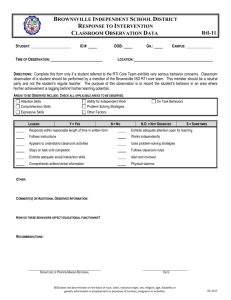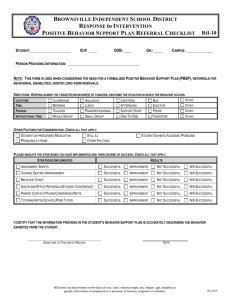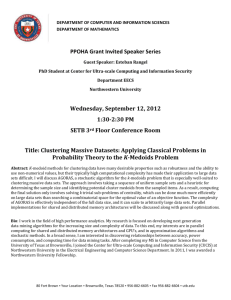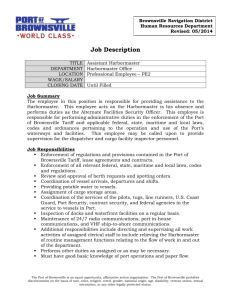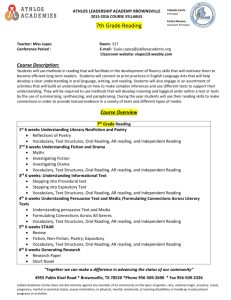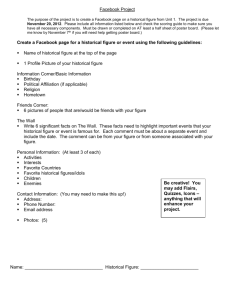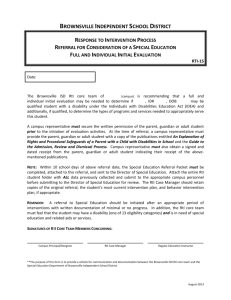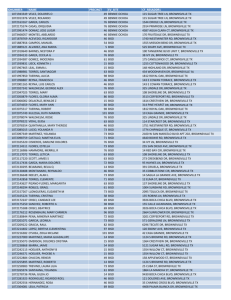Project Brief
advertisement
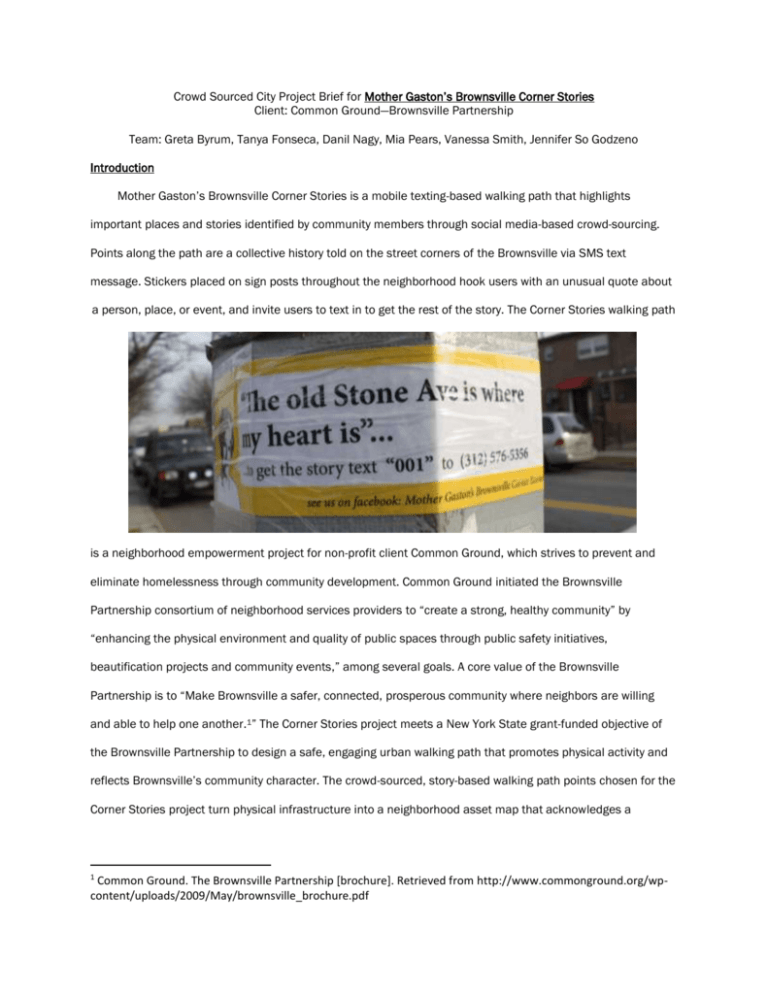
Crowd Sourced City Project Brief for Mother Gaston’s Brownsville Corner Stories Client: Common Ground—Brownsville Partnership Team: Greta Byrum, Tanya Fonseca, Danil Nagy, Mia Pears, Vanessa Smith, Jennifer So Godzeno Introduction Mother Gaston’s Brownsville Corner Stories is a mobile texting-based walking path that highlights important places and stories identified by community members through social media-based crowd-sourcing. Points along the path are a collective history told on the street corners of the Brownsville via SMS text message. Stickers placed on sign posts throughout the neighborhood hook users with an unusual quote about a person, place, or event, and invite users to text in to get the rest of the story. The Corner Stories walking path is a neighborhood empowerment project for non-profit client Common Ground, which strives to prevent and eliminate homelessness through community development. Common Ground initiated the Brownsville Partnership consortium of neighborhood services providers to “create a strong, healthy community” by “enhancing the physical environment and quality of public spaces through public safety initiatives, beautification projects and community events,” among several goals. A core value of the Brownsville Partnership is to “Make Brownsville a safer, connected, prosperous community where neighbors are willing and able to help one another.1” The Corner Stories project meets a New York State grant-funded objective of the Brownsville Partnership to design a safe, engaging urban walking path that promotes physical activity and reflects Brownsville’s community character. The crowd-sourced, story-based walking path points chosen for the Corner Stories project turn physical infrastructure into a neighborhood asset map that acknowledges a 1 Common Ground. The Brownsville Partnership [brochure]. Retrieved from http://www.commonground.org/wpcontent/uploads/2009/May/brownsville_brochure.pdf community-generated recollection of the past, and enables residents to identify important places and people that can frame Brownsville’s vision for the future. Creating an Asset Map through Stories Community pillar “Mother” Rosetta Gaston (1885-1981) founded Brownsville Heritage House, an inspiration for Corner Stories. Mother Gaston was an activist committed to teaching Black children about their heritage; she envisioned Heritage House as an educational and cultural center where Brownsville residents young and old could exchange individual and community knowledge to strengthen local bonds and neighborhood pride. We’ve brought this vision of a collective local heritage into the social media age through use of mobile texting technology, Facebook, and digital mapping. By curating and spatializing crowd-sourced stories from Facebook and bringing them on the street to share via stickers and text message, we tangibly situate local narratives in place. Building community cohesion through collective narratives of history, strength and pride is important in a place where the dominant internal and external discourse is about poverty, violence, drugs, and hopelessness. While it is naïve to ignore or gloss over the difficult realities facing the Brownsville neighborhood, we and our client Common Ground believe that many problems facing the Brownsville are ostensibly related to the erosion of community ties. Corner Stories provides an outlet for residents to share all kinds of stories—stories of fun times, achievements, heroes and characters from past and present, laments about what once was, and what the community can become. Elements of our Corner Stories walking path are based on the Yellow Arrow global public art project (yellowarrow.net) and the Cripplebush Ghost Tour of Williamsburg, Brooklyn (cripplebush.org). Both use SMS texting platforms to share “secret” histories that enhance the knowledge and experience of urban space. Through disseminating crowd-sourced stories in Brownsville, we hope Corner Stories will inform the way the space is perceived by residents and show that these spatialized stories cluster around community hubs that should be acknowledged and invested in as neighborhood assets. Asset mapping is an alternative to a needs-based approach to community development. A needs assessment emphasizes what is lacking in a devastated neighborhood, while an asset-driven approach catalogues the positive capacity that does exist in the form of people, places, skills, and knowledge. 2,3 It is a relationship-based understanding of urban neighborhoods that aligns with the visions for Brownsville articulated by Common Ground/Brownsville Partnership and Mother Gaston. An inherent difficulty in creating an asset map though is how to engage residents in contributing to it. What is the incentive for someone to share with you (especially if you are a community outsider) about their favorite local places, or the important people in their lives? What would compel someone to check off some boxes on a survey to advance a goal as nebulous as “community development?” As our team found through our social media-based research though, sharing of stories is an inherent incentive. While it feels like work to attend community focus groups or read through data summaries, people will often gladly volunteer stories about their lived experiences and enjoy learning about those of their neighbors. The many stories we found casually shared on Facebook get at these same research questions—what/where/who are important community assets—and amazingly these candid and interesting stories are publically available in the crowd-sourced cloud of the social media universe. 2 Best Practice Brief No. 4. Michigan State University (1999). http://outreach.msu.edu/bpbriefs/issues/brief4.pdf Kretzmann, John P, and John L. McKnight. (1993). Building Communities from the Inside Out: A Path Toward Finding and Mobilizing a Community's Assets. Evanston, IL: Institute for Policy Research. Retrieved from IPR Publications Web site: http://www.northwestern.edu/ipr/publications/community/introd-building.html. 3 Data We tapped into an existing source of crowd-sourced story data in the pilot/demonstration phase of Corner Stories by gathering quotes and stories shared via Facebook in the Discussion Board section of a popular Brownsville community page4. Discussion Board topics initiated by group members encourage sharing of collective history through threads like “Who Remembers Bobby Simmons?” or “Brownsville and the Blackouts. Where were you?” The Brownsville page on Facebook seemed an appropriate place to start gathering stories, as it has about 11,000 members of varying ages. This is a fairly sizable segment of the nearly 90,000 residents of Brownsville. The page has significant daily “Wall” traffic in the form of comments and “likes,” indicating an active and engaged membership. Our team curated this crowd-sourced knowledge to kick-start the Corner Stories pilot and create the street corner stickers as a demonstration project to model how this stories-based walking path would work. A complementary Facebook presence—a community page for Mother Gaston’s Brownsville Corner Stories, and a profile page for the late Rosetta Gaston—is designed to engage residents and encourage them to share more crowd-sourced, place-based stories. Such stories would compose a more permanent Corner Stories walking path that can be installed by client Common Ground in spring/summer 2011. A public Google map shows the locations of the points on the path, and can be embedded within a Facebook page to advertise the project. 4 Brownsville, Brooklyn NY. Retrieved December 14, 2010 from Facebook: http://www.facebook.com/pages/Brownsville-Brooklyn-NY/80816410237 Process and Future Recommendations The end product of the Corner Stories platform appropriately reflects an asset-based approach to research—we tapped into data and a strong community form that already existed in the Brownsville virtual community as the focal point for our story gathering, curation, and outreach. Prior iterations in project development involved design of a new digital data crowd-sourcing platform (e.g., Crowdmap5) that addressed perceived deficits in community mapping resources. This would have required training to instruct local residents in how to access and curate the Crowdmap, as well as significant outreach to increase the profile and popularity of its use. It also required our team (and the eventual end user, Common Ground) to create somewhat artificial categories of types of places that residents should nominate, with the hope that people would respond to these research questions out of self interest. “Official” historical facts were used in a “Bricks of B’Ville” branded pilot tour, which our test audience of Brownsville teens found boring and unrelateable as a template for adding their own points of interest to a crowd-sourced tour. By contrast, the current Facebookbased data gathering strategy takes advantage of a sizeable online community of users and taps into their familiarity with the Facebook interface as a place to share and gain local and interpersonal knowledge. The current Corner Stories pilot tour adheres as much as possible to the actual words of Brownsville residents discussing topics they find interesting, and thus uses what should be relatable examples of story-based data. While the Facebook-based platform seems a solid way to approach community asset mapping, we believe that it will require the right people—influential residents who have credibility in the neighborhood—to carry this project forward. A significant limitation we encountered in attempting to gather new stories from residents (versus just using existing stories in Facebook discussion threads) was that we were clearly coming from outside the community. There was little interest in sharing stories on Mother Gaston’s Brownsville Corner Stories community page which we built. Perhaps given more time to build rapport we could have gathered more data and interest. But an asset-focused approach to project development for Corner Stories points toward harnessing existing interpersonal capacity—the trust that Brownsville residents already have in community leaders—to turn this project into a useful, engaging, and sustainable neighborhood resource for improving community cohesion and health in Brownsville. 5 Crowdmap, Powered by Ushahidi. http://crowdmap.com/
